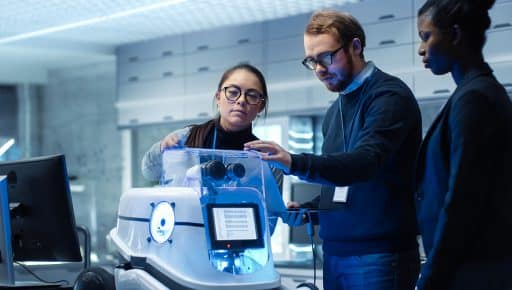There are still very few robots to be found in commercial buildings, but it’s an environment they can have a real future in if they focus on occupant comfort and behaviour. Philippe Conus, director of the VINCI Facilities brand, explains.

© Gorodenkof
Are robots starting to carve out a place for themselves in businesses?
Ph.C. Robots haven’t yet become commonplace in working environments. Far from it. The most “advanced” businesses are probably cleaning service providers that operate in industrial settings, primarily in highly standardised spatial configurations that present few obstacles to robot movement. I’m thinking of warehouses in particular. What few applications do exist in service businesses are usually part of pilot schemes.
Why is that?
Ph.C. The development of robotics in commercial environments is closely linked to the opportunities offered by artificial intelligence (AI) and its specific applications aimed at occupant comfort. Our expertise covers some of these applications, which are used under real conditions in a number of buildings. These include real-time analysis and modulation of air quality or of noise and light levels; early optimisation of space based on occupancy; optimal provision of communication tools and off-site travel management. And they go right through to “empathic buildings”, which inform each occupant of the best way to use space and equipment depending on their personal profile. If robots are not seen first and foremost as a means to improve wellbeing and facilitate experiences, then they have no future. It’s not a question of getting rid of duties, still less jobs, but about delivering real added value in terms of service. Robot deployment is therefore based both on AI innovation and on accurate monitoring of pilot schemes.
“It’s not a question of getting rid of duties, still less jobs, but about delivering real added value in terms of service”
Which applications are you working on?
Ph.C. We will shortly be testing “robots as a service” on fairly low value-added repetitive tasks, such as visitor guidance. Here again, the aim is to enhance the human dimension. By entrusting intelligent machines with guidance tasks, receptionists can focus on delivering quality service without any break in continuity. Furthermore, the beauty of robots is that they can perform a variety of tasks. When they’re not being used as a guide, they can also be given technical administrative duties: headcounts, inventories, and detection of inappropriate objects on the premises and lighting faults. And of course they can send alerts.
In what way can robotics benefit from artificial intelligence?
Ph.C. The more information robots have, the more they will be able to refine the service they provide. That’s why it’s important to work in parallel not just on data analysis but also on intelligence. For example, VINCI Facilities has created a mega-tool to visualise and manage data from all of its central applications (BMS, BIM, CMMS, IoT, and our client portal Wayin’) in real time. The next step, scheduled for 2018, is to add a layer of artificial intelligence that will make it possible – using recurrence, calculation and trend analysis – to send increasingly accurate alerts to the right place, and to refine and personalise the way we respond to end clients while at the same time optimising technician call-outs.
Sources: IDC
10/10/2017


